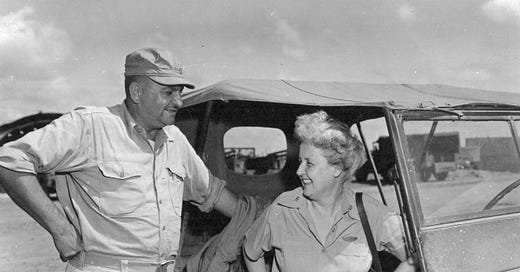Barbara Finch found a way to the front lines in the Pacific
Several husband-wife correspondent teams covered World War II together, from Reynolds and Eleanor Packard in Italy to Shelley and Carl Mydans and Melville and Annalee Jacoby in the Pacific -- not to mention Ernest Hemingway and Martha Gellhorn.
For Barbara and Percy Finch, China was the longtime base of operations. Percy, a Brit born Oct. 20, 1897, spent nearly 20 years working in Shanghai. The former Barbara Miller, born Oct. 10, 1902 in Des Moines, wasn't based there quite as long but considered it home. When Percy was interned following the U.S. entry into the war, she stuck with him until they were repatriated to England in August 1942, where Barbara would spend a year working for the Red Cross.
They eventually wound up back in the Pacific theater, reporting for Reuters. Percy spent a significant amount of time with the U.S. Marines in 1944 and 1945 and later co-wrote Gen. Holland "Howlin' Mad" Smith's memoir, Coral and Brass.
One of Percy's most widely printed dispatches came upon landing at Guam. His lead: "The way the Japanese told it, the Pacific war had just about been won -- by Japan." Finch had spoken to islanders who said the Japanese claimed they had captured Hawaii, sent a fleet through the Panama Canal, and occupied Washington, D.C.
Barbara, like other women in her field, had extreme difficulty getting close to the action. An August 1944 item in the Los Angeles Times, where she had worked earlier in her career, noted pointedly that Finch "spends a good part of her time trying to convince the Navy she is a reporter, not just a woman."
The Navy finally accredited her in October 1944 — the first female correspondent so recognized by the service — but she still had to find a workaround to get to the front lines. On March 2, 1945, she caught a ride aboard one of the first Navy medical evacuation planes to land on Iwo Jima, making the flight as a "volunteer nurse's aid." Her widely published story told of the relief wounded servicemen expressed at escaping the hellscape of Iwo:
It is a stimulating experience. Every man on the plane -- even the gray-faced Marine who lost his left leg and most of the toes on his other foot by mortar fire -- brightens eagerly at the mention of a hospital. To him it means real beds and cleanliness and rest by nightfall.
The Marine dozed off when first we took off from Motoyama airfield No. 1 at Iwo Jima. He stirred restlessly and motioned me close to his litter.
“Are we still moving?” he asked.
Our plane, the Nellie V, piloted by Lieutenant Daniel H. Duren, United States Navy, of San Diego, was moving so smoothly 9,000 feet above the white clouds and blue water that his question was understandable. When I reassured him, he smiled faintly, sighed and closed his eyes.
Navy flight nurse Jane Kendeigh soon followed Barbara to Iwo Jima, and on April 7 the pair were aboard one of the first evacuation flights into Okinawa. Interviewed by the Honolulu Advertiser on April 11, 1945, Kendeigh mused of the woman about 20 years her senior, "Mrs. Finch really gets around."




